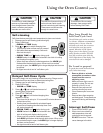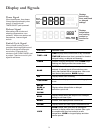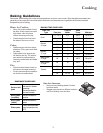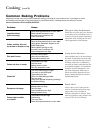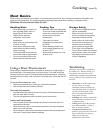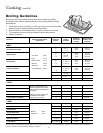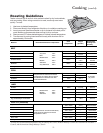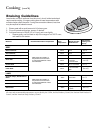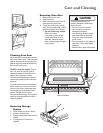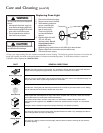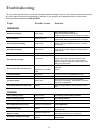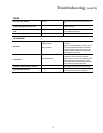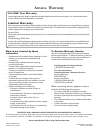
23
Care and Cleaning (cont'd)
For routine cleaning, allow top to cool before cleansing. Wash surface with a dampened cloth and smoothtop cleaner
conditioner. Use another clean damp paper towel to wipe off the cleaner. Use a dry paper towel, buff the smoothtop to
make sure all the cleaner conditioner is removed. The smoothtop cleaner conditioner provides a thin layer of protective
polish that helps prevent scratching. Do not use a harsh cleanser or steel wool pad. For specific problems, see below.
Caring for the smoothtop
Cleaning Stainless Steel
(Some models)
Stainless steel ranges have been factory finished for high shine and luster.
To maintain this quality appearance:
Can I use liquid cleaners
on my stainless steel?
Just because a cleaner is a liquid
does not mean it is
non-abrasive. Many liquid cleansers
designed to be gentle on tile and
smoothtop ranges still damage stainless
steel. Cosmetic damage from using
non-recommended products is not
covered under warranty.
Damage to stainless steel finish due to improper use of cleaning
products, or using non-recommended cleaning products, is not covered
under warranty. For Amana recommended products, call our Consumer
Affairs division at (800) 843-0304.
Citric Acid
To prevent damage to the
finish of your stainless
steel range, do not allow
mustard, tomato juice, marinara
sauce, or other citrus based sauces
or products to remain on stainless
steel surface. Citric acid permanently
discolors stainless steel.
PROBLEM CAUSE REMOVAL
Brown streaks
and specks
Cleaning with sponge or cloth containing soiled
detergent water.
Normal cleansing (provided above).
Blackened, burnt
on spots
Spatters or spillovers on a hot cooking area or
accidental melting of plastic like a bread bag.
Clean area with smoothtop cleaner conditioner with
clean damp paper towel, nonabrasive nylon pad, or
scouring brush.
If spot is not removed, on cool cooktop carefully scrape
area with a safety scraper held at a 30-degree angle.
Fine brown gray
lines, fine
scratches or
abrasions
Course particles, like salt, become embedded in top
if trapped under pan. Using abrasive cleaning
materials. Scratches from rough ceramic, glass, or
ceramic coated cookware.
Fine scratches are not removable but can be minimized
by daily use of smoothtop cleaner conditioner.
Smearing or
streaking
Using too much smoothtop cleaner conditioner or
using a soiled dish cloth.
Follow label instructions carefully. See Routine
Cleaning, above.
Metal or
silver/gray marks
Sliding or scraping metal utensils across top.
Remove marks before top is used again. If marks are
not removed by normal cleaning, use a safety scraper at
a 30° angle and cooktop cleaner conditioner to carefully
scrape off the mark.
Pitting or flaking
Boilovers of sugar syrup on a hot smoothtop can
cause pitting if not removed immediately.
Turn control to LOW setting. Wipe up excess spill with
dry cloth. Allow top to cool and carefully scrape area
with a safety scraper held at a 30-degree angle.
Hard water spots
Condensation from cooking can cause minerals
found in water and acids in food to drip onto
smoothtop and cause gray deposits. Spots are often
so thin they appear to be in or under smoothtop.
Mix smoothtop cleaner conditioner with water and apply
thick paste to stained area. Scrub vigorously. If stain is
not removed, reapply cleaner and repeat process
OR
make sure the surface is cool and put a small amount of
white vinegar on the spot and let it sit a few minutes.
Use a nonabrasive nylon pad and gently rub the spot.
Wipe off any excess with a damp paper towel, then dry.
DO USE:
• Warm soapy water for routine
cleaning on a cool range.
• Dry with soft, clean cloth.
• For heavy soil, ONLY a stainless
steel cleaner designed for
kitchen appliance use.
DO NOT USE:
• Abrasive powders or liquids
• Citrus based cleaners
• Ammonia
• Steel wool pads
• Abrasive cloths
• Oven cleansers
• Acidic or vinegar based cleaners



